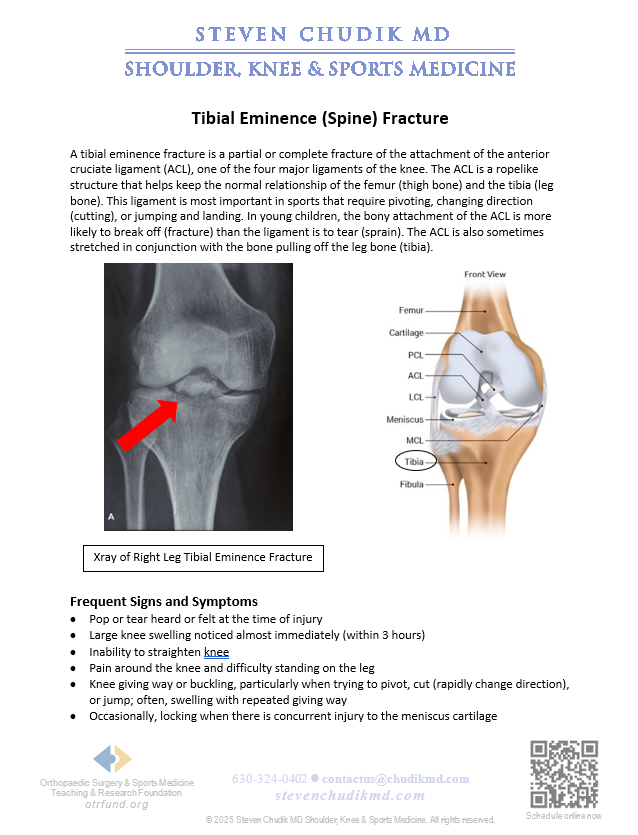 Online appointment scheduling is easy, convenient anytime on any device
Online appointment scheduling is easy, convenient anytime on any device
Home / Knee Surgeon Chicago Illinois / Fractures / Tibial Eminence (Spine) Avulsion
A tibial eminence fracture is a partial or complete fracture of the attachment of the anterior cruciate ligament (ACL), one of the four major ligaments of the knee. The ACL is a ropelike structure that helps keep the normal relationship of the femur (thigh bone) and the tibia (leg bone). This ligament is most important in sports that require pivoting, changing direction (cutting), or jumping and landing. In children the bony attachment of the ACL is more likely to break off (fracture) than the ligament is to tear (sprain). However, this ligament is often stretched in conjunction with the bone pulling off the leg bone (tibia). This is because the bony attachment connects to the leg bone via growth plate cartilage, which is weaker than the ligament. Associated injuries to the collateral ligaments (on either side of the knee) or the meniscus cartilage occur often with this injury. A tibial eminence fracture is caused by force that exceeds the strength of the growth plate. This injury may be as a result of a noncontact injury (landing awkwardly or cutting while cleats are stuck to the ground) or from contact, such as getting tackled at the knee.
Initial treatment consists of medications and ice to relieve pain and reduce the swelling of the knee. If the bone is in the proper position or can be positioned without surgery, immobilization with a brace or cast for four to six weeks is recommended. Crutches may be recommended for walking. If the bones are not in proper position, surgery is usually needed to reposition the bones and hold them with sutures, wires, or screws. After immobilization (with or without surgery), stretching and strengthening of the injured and weakened joint and surrounding muscles (due to the injury and the immobilization) are necessary. These may be done with or without the assistance of a physical therapist or athletic trainer. The sutures, wires, or screws usually do not need to be removed.
Learn More
 Competitive running, bicycling back on energetic executive’s schedule between work, volunteering
Competitive running, bicycling back on energetic executive’s schedule between work, volunteering
Dr Steven Chudik founded OTRF in 2007 to keep people active and healthy through unbiased education and research. Click to learn about OTRF’s free programs, educational opportunities and ways to participate with the nonprofit foundation.
1010 Executive Ct, Suite 250
Westmont, Illinois 60559
Phone: 630-324-0402
Fax: 630-920-2382
(New Patients)
550 W Ogden Ave
Hinsdale, IL 60521
Phone: 630-323-6116
Fax: 630-920-2382
4700 Gilbert Ave, Suite 51
Western Springs, Illinois 60558
Phone: 630-324-0402
Fax: 630-920-2382

© 2026 © 2019 Copyright Steven Chudik MD, All Rights Reserved.
